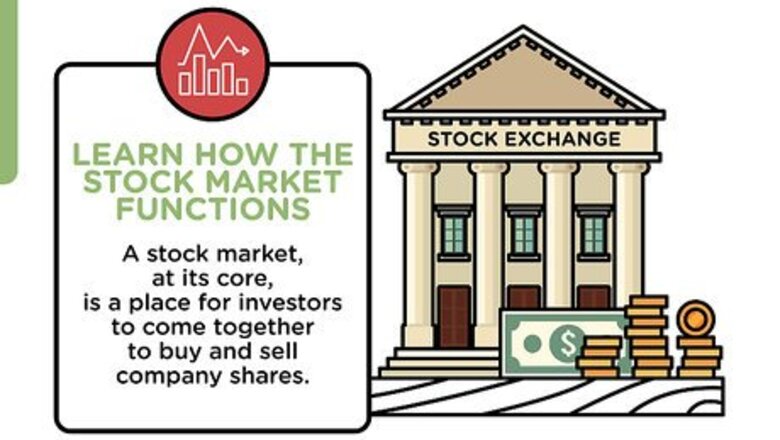
views
Investing Your Money Wisely

Learn how the stock market functions. A stock market, at its core, is a place for investors to come together to buy and sell company shares. Just about every country with trading and public company ownership has a stock market to trade in, often with more than one index, as is the case in the U.S. with three major indexes: the Dow Jones, the S&P 500, and the NASDAQ Composite. The NASDAQ index tends to have a large amount of high-growth tech companies listed, making it a great choice for investing in energy, tech development, and similar fields. It does have other types of companies listed, but tends to focus on the tech industry.
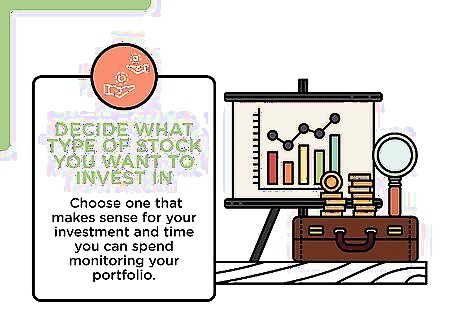
Decide what type of stock you want to invest in. There is a variety of stock options, some that you invest in individually, some that you contribute to a fund with that is then invested, and others that work according to their own processes. Choose one that makes sense for your investment and time you can spend monitoring your portfolio. Individual stock: A stock that requires a lot of individual responsibility, this is one that you will invest in by yourself with no other financiers or assistance. Mutual fund: A pool of money from multiple investors to be used for buying large stocks or collections of stocks you wouldn’t usually be able to get on your own. Typically managed as a joint effort. Index fund: A type of mutual fund that is made to track and follow a market index, usually with a broad scope but low turnover. Exchange-traded fund (ETF): Similar to a mutual fund in many ways, an ETF trades constantly throughout the day and track a specific index, whereas a mutual fund only trades at the end of each day, and can also have a focus on international stock trading rather than just domestic.
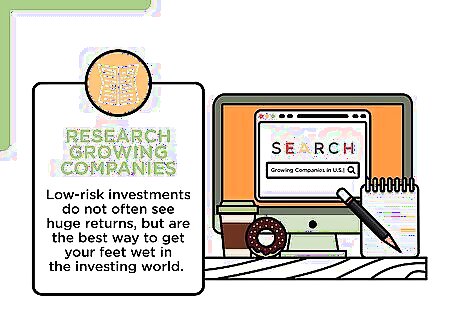
Research growing companies to find a low-risk investment. It’s important that your first stock purchase be a safe and reliable one. Low-risk investments do not often see huge returns, but are the best way to get your feet wet in the investing world before moving on to riskier, and potentially more profitable, opportunities. Check companies directly for annual reports to assess their long-term success. A company that has been around for a decade making steady but slow gains will always be a safer investment than a new business that has a recent spike in profit. Think about companies you purchase goods and services from regularly - corporate chains and national businesses are usually safe bets for long-term low-risk investment. You can research directly on the NASDAQ index online, but other useful sites to research with include the Wall Street Journal, stockchase.com, or investopedia.com.

Settle on a handful of companies to invest in. Plan to spread your money around on a few safe stocks on this first venture into investing. An essential part of being a successful investor, you will avoid losing everything on a single company if their stock turns sour. Having an investment start going bad is a regular event that is easy to handle. As long as your other investments continue to be successful, they can help to recoup losses.
Purchasing a NASDAQ Stock
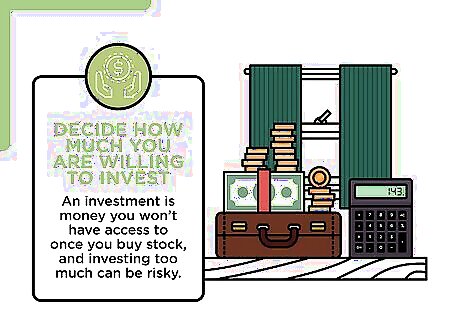
Decide how much you are willing to invest. An investment is money you won’t have access to once you buy stock, and investing too much can be risky. On the other hand, too small an investment will have you making only a small amount of money, which makes the effort of investing less worthwhile. About 10 percent of your net income is a common amount to invest, but setting aside 5 percent of your income is a good starting amount for a novice investor.
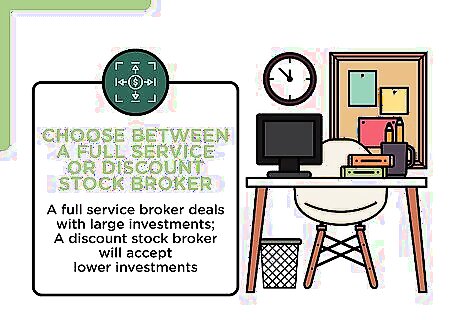
Choose between a full service or discount stock broker. A full service broker deals with large investments, often more than $10,000, and can be contacted for investment advice and guidance. A discount stock broker will accept lower investments, some as low as $1,000, but investment decisions will be entirely your responsibility. You will buy stock through your brokerage account nearly all of the time, but sites such as E-Trade and Ameritrade allow you to purchase stock without one. There are online brokers available who accept lower minimum account balances, which can be a good option if you are looking to buy NASDAQ stock with less than $1,000 in initial funds. You can also purchase stock through a direct stock purchase (DSP) plan available from the company directly. These plans have minimum restrictions, usually a few hundred dollars as the initial balance.
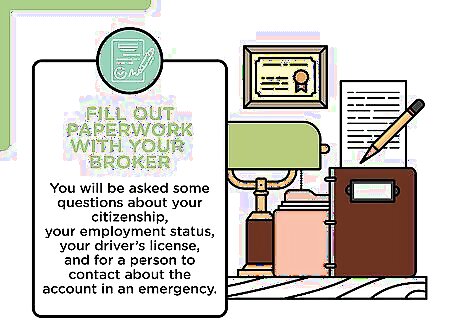
Fill out paperwork with your broker and open an account. Discuss with your broker the terms and conditions of your brokerage account, which usually includes a new account application, a decision of what type of account you want, and any other paperwork your state requires. You will be required to deposit a minimum for the initial account balance, so make sure ahead of time that the amount you want to invest meets this minimum. You will be asked some questions about your citizenship, your employment status, your driver’s license, and for a person who can be trusted to contact about the account in an emergency. Be sure to understand the SEC (Securities and Exchange Commission) and FINRA (Financial Industry Regulatory Authority) rules in your state, and carefully read every paper you are asked to sign. This is your money, and you need to be 100 percent certain of how it will be used and what exactly you are agreeing to.

Use an app to handle investments without a broker. Mobile apps such as Robinhood and Stash are designed to allow you to make new investments and monitor your portfolio all in one place. Most of these apps do not require a minimum balance, and can serve as a way to get your feet wet in stocks and investing. While most do not require a minimum balance in the traditional sense, you will still need to pay fees for each stock purchase the same way you do when you purchase stock through a broker.
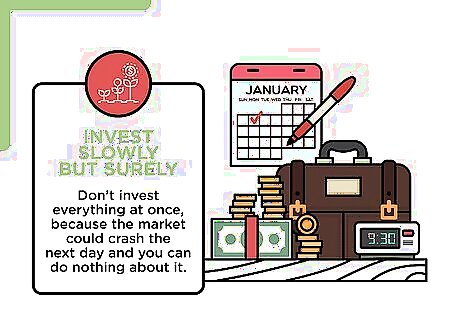
Invest slowly but surely over the course of a few months. Don’t invest everything at once, because the market could crash the next day and you can do nothing about it. Instead, come up with a plan to slowly buy stock over the course of a couple months, ensuring that your returns trickle in without major market issues affecting your funds. This can help you to avoid bad investments initially. By giving yourself a few weeks to suss out a company, you can be more confident about it when you do decide to purchase, or decide to not buy their stock if things start to look like they’re going sour.
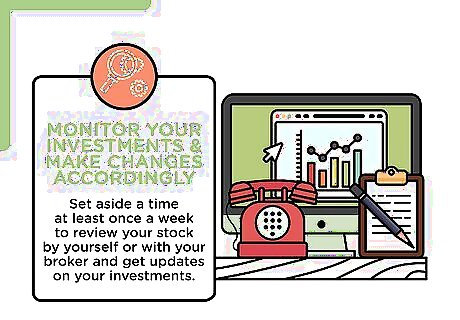
Monitor your investments and make changes accordingly. Set aside a time at least once a week to review your stock by yourself or with your broker and get updates on your investments. You do not want to go too long without monitoring your portfolio or risk not being aware of sudden changes and losses. Once a week is a good starting point for an investor as it allows you to see patterns and trends over the course of a few days. You can check it more often, but you will be seeing daily changes rather than weekly patterns. It is recommended to analyze patterns over time rather than individual fluctuations, as it is a better indicator of a stock’s overall success.
Developing Your Portfolio Further
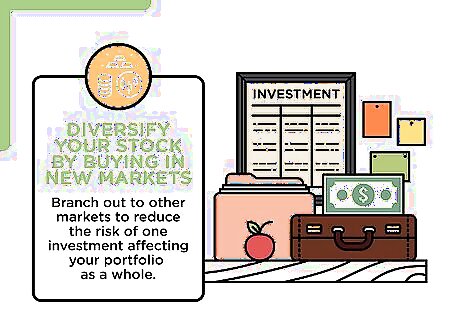
Diversify your stock by buying in new markets. In the investing world, you’re going to hear the phrase “diversify your stock” thrown around a lot. What this really means is that instead of investing everything in one corner of the market, branch out to other markets to reduce the risk of one investment affecting your portfolio as a whole. For example, if you have been primarily investing in the renewable energy industry, find a market completely unrelated to renewable energy to broaden your reach, such as housing development. Don’t keep all your eggs in one basket, it’s better to have your finger in every pie.

Increase the funds available in your brokerage account. Add funds to areas that are particularly successful to maximize your returns. Reduce funds from areas that are underperforming to reduce their effect on your overall investment. If you don’t want to add funds to your account and would rather just use the money in there already, you can sell some investments and add those funds to your successful stocks. Establish a quarterly and annual assessment of your portfolio, to see long-term trends and re-evaluate your priorities over time. You may see a different picture of your investments over the course of a year than over the course of a month.

Look into international investments to spread your money around the world. Foreign investments are a great way to diversify with international exposure in mind. You can buy international stock through an ETF (an exchange-traded fund) that specifically focuses on international investment opportunities. Instead of navigating through international waters, as it were, you can also invest in a multinational company with headquarters in your home country to venture into international stock trading.




















Comments
0 comment